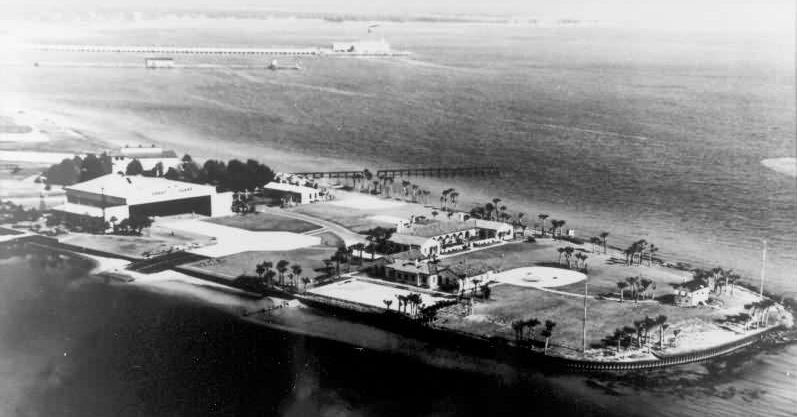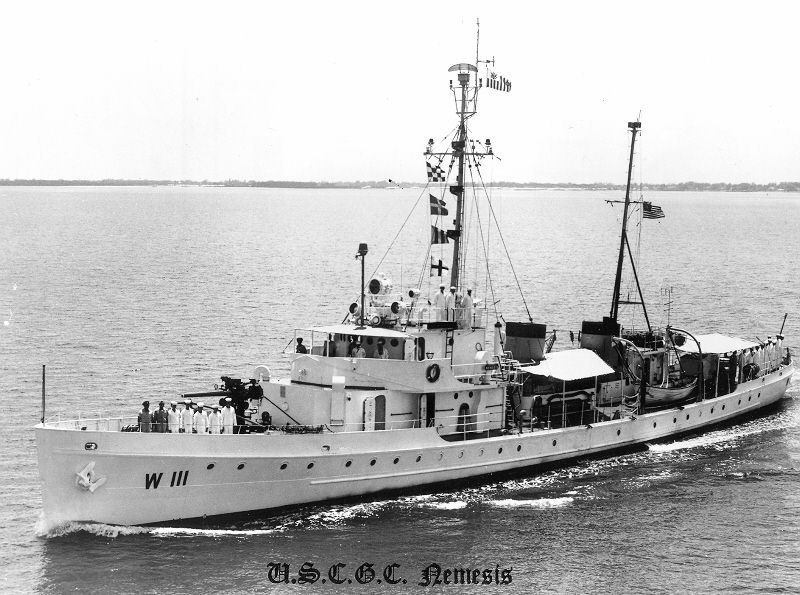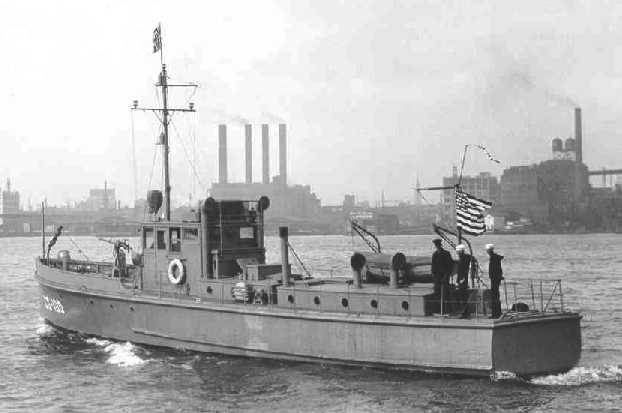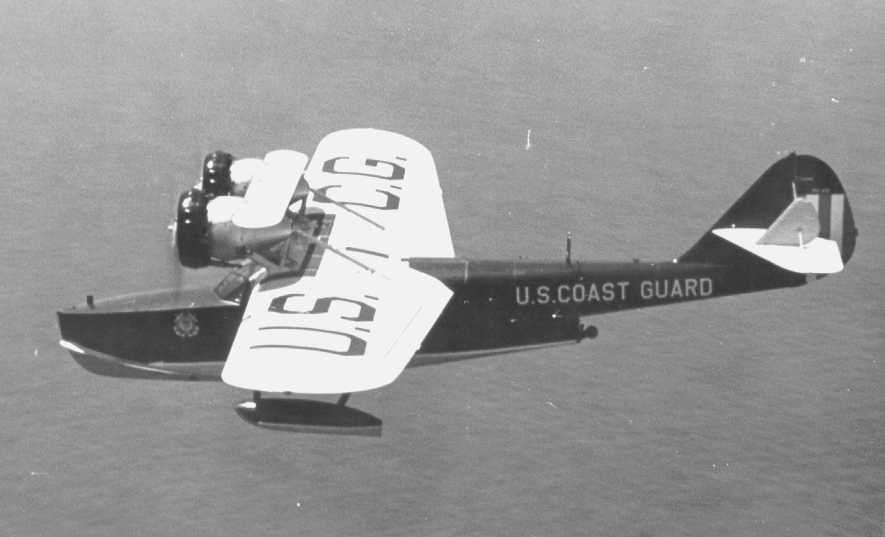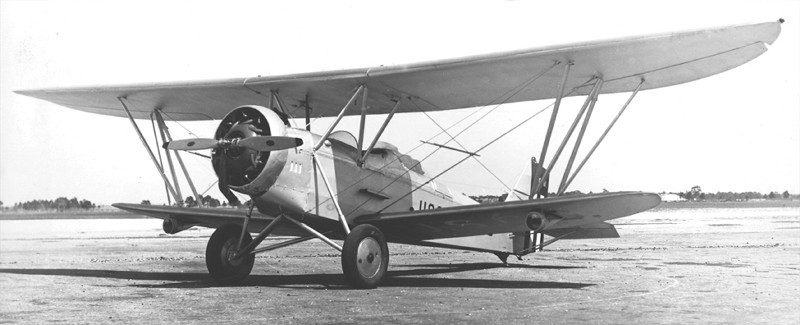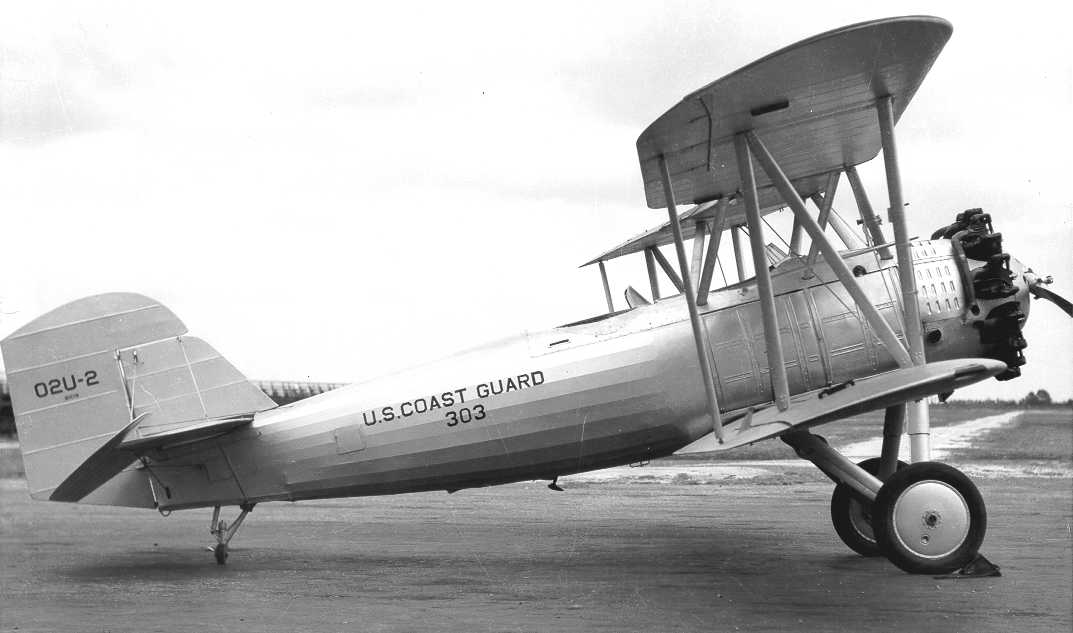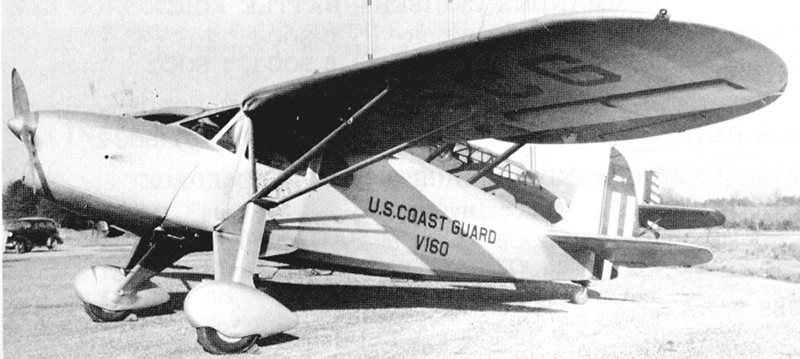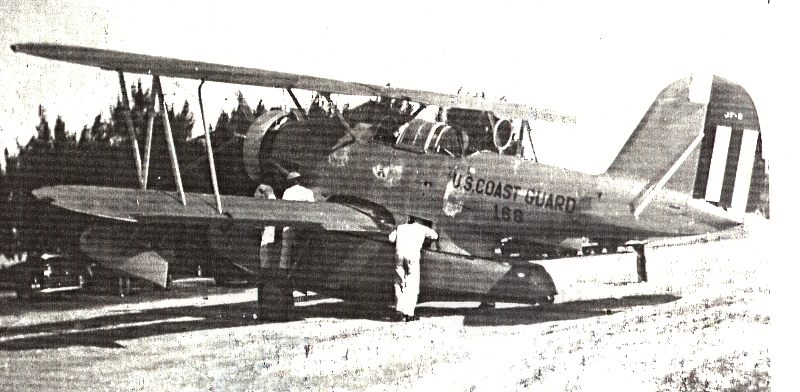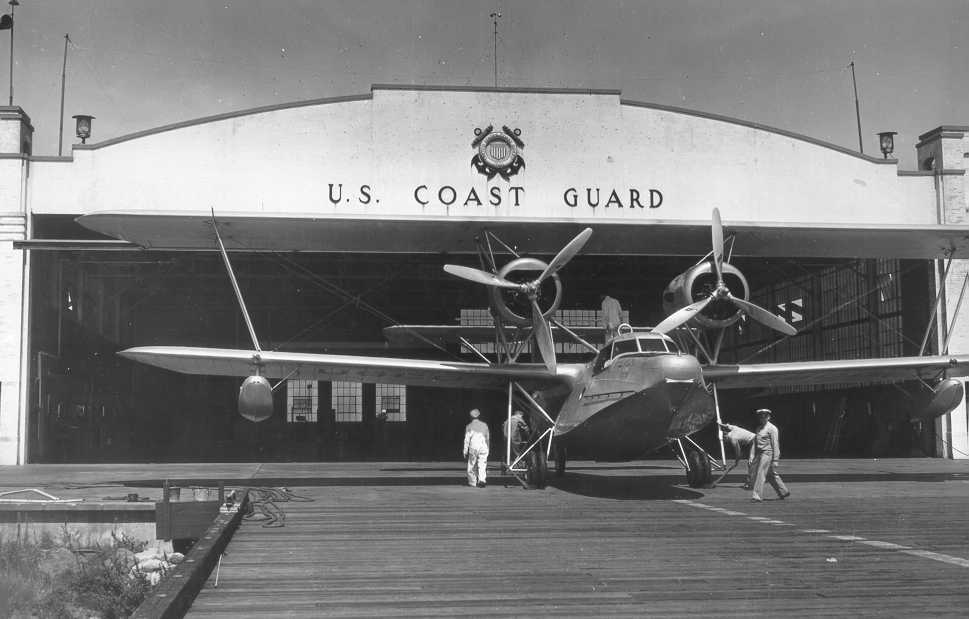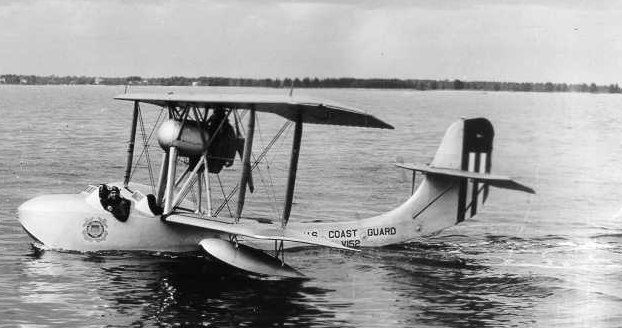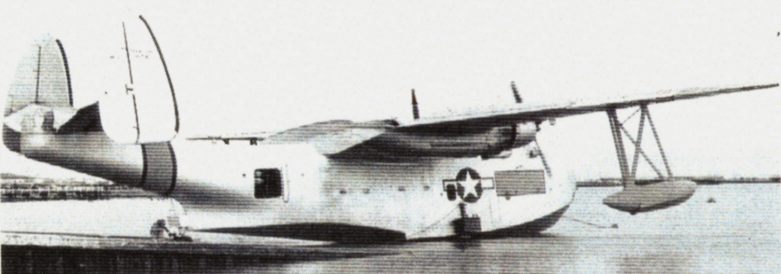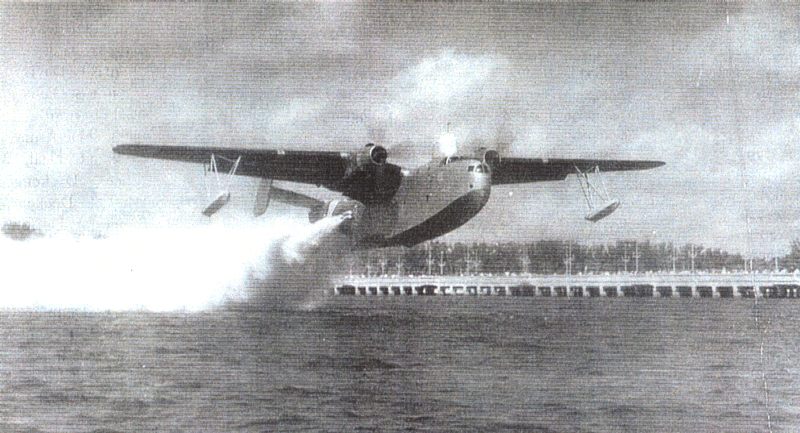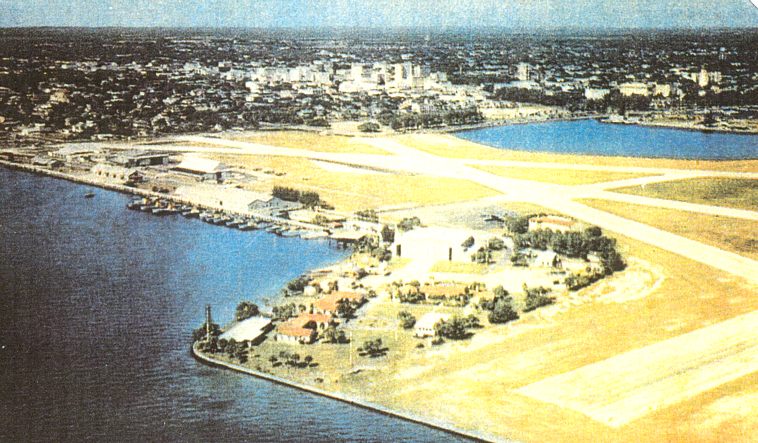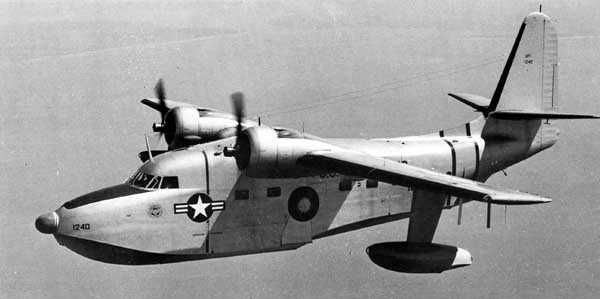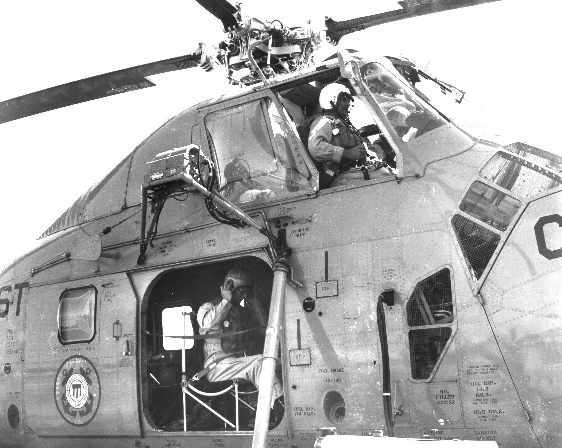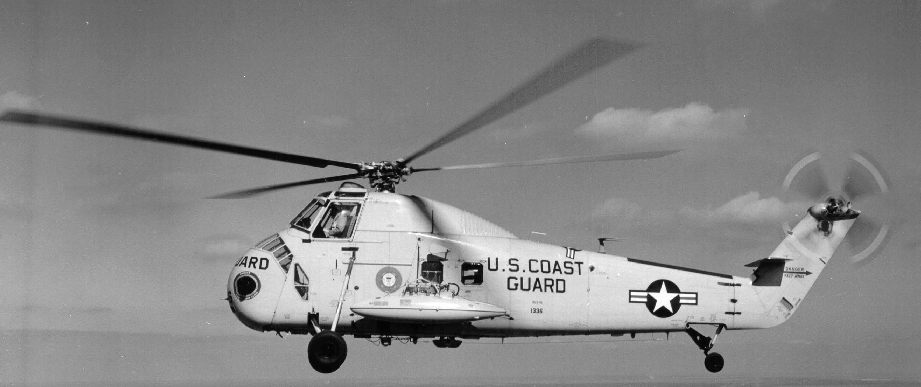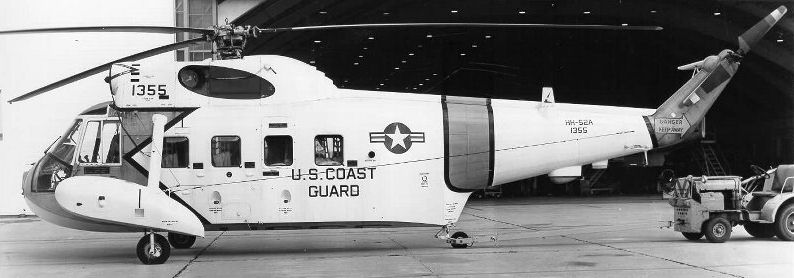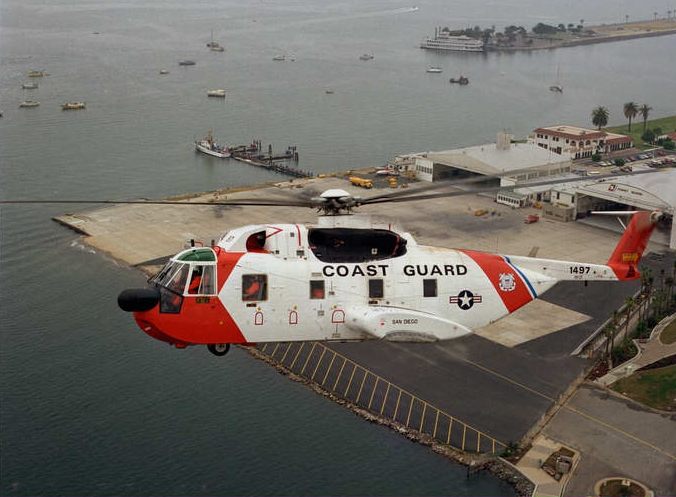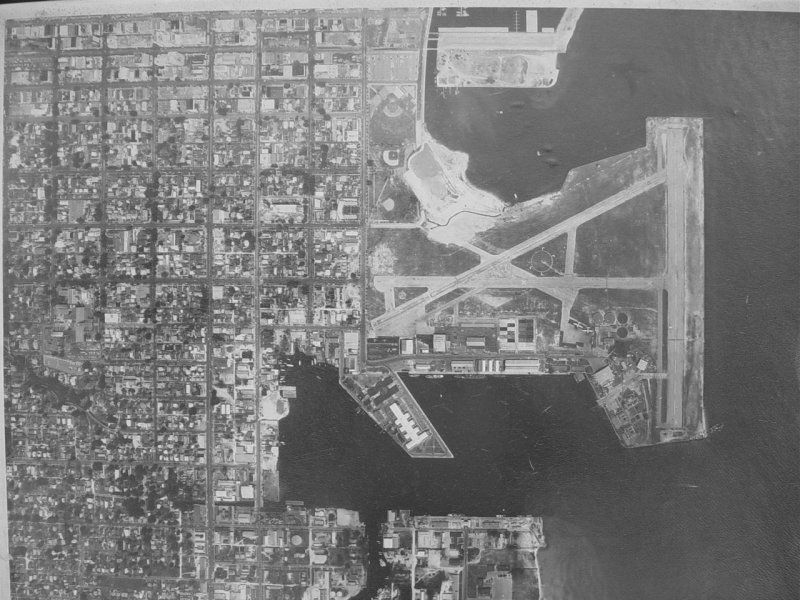|
When James R. Lee gave me the idea for this article, it was about two rescue missions. First, the successful save of the "Eddie H", by the crew of the UF-1G #2124, and the second of the successful save of "The Flying Girl" but the tragic loss of the HU-I6E #1240 and its six man crew. Aviation Ordnanceman Lee was the "bombardier" on the first mission and had many friends on the second mission. My father was one of the first enlisted men assigned to Air Station St. Petersburg, back before it was placed in commission and I knew Perrott, Morris, and Eubank, who's son was my good friend. As a boy, I spent many hours at the Air Station, and was on station that summer day when they gave every thing they had to accomplish the mission. I later served at St. Pete as an Aviation Machinist Mate, and clearly recall how very busy we always were. Many years later, I was a Navigator Bombardier on Air Force B-47E bombers. I never suffered the experience that caused HUS-IG #1334 and #1335 to try their best to save fellow aviators, but I was happy to know they would be there trying, along with citizens like Mr. O. R. Singleton, if I ever needed them. So the article sort of grew to try in some small way to honor those men who really were "Always Ready". I would also hope this small effort will encourage others to write about the successful missions. I know many of you Coast Guardsmen have a wealth of information, please don't let it just "fade to black". There are many of us who are truly interested. St. Petersburg, Florida, commonly referred to as "Saint Pete," is located on the western shore of Tampa Bay, about half way up the West Coast of Florida. St. Pete was the western terminus of the world's first scheduled airline, The St. Petersburg and Tampa Airboat Line. The Airboat Line used a Benoist type XIV flying boat on its first flight on 1 January 1914. The distance was eighteen miles, and took 23 minutes. The fare was five dollars. As St. Pete grew, aviation grew with it, and the City built the Albert Whitted Airport on land jutting out into Tampa Bay from the south east section of the city. On 17 January 1920, the Eighteenth Amendment to the U.S. Constitution was passed by the Congress over the veto of President Woodrow Wilson. Called the Volsted Act, the Amendment prohibited production, importation, or sale of alcoholic beverages, creating what was commonly called "Prohibition." The U.S. Coast Guard was charged with preventing the importation of "Smuggled Spirits" into the United States, and various vessels attached to Coast-Guard Base 21, St. Pete, performed their law enforcement duties in what became "The Prohibition (or Rum) War." Base 21 performed these duties until 5 December 1933, when the Twenty-First Amendment was ratified by the states, repealing "Prohibition." The prime responsibility of the Coast Guard, the "Saving of Lives at Sea" had never really been set aside during Prohibition, and it once again took on primary importance. To provide more effective life saving service along Florida's western coast, a decision was made to build an Air Station and Radio Station at St. Pete. It was to be equipped with three or four seaplanes or amphibians, several of which would be classified as Air Ambulances. These aircraft, capable not only of conducting aerial searches over the vast waters of the Gulf of Mexico, would also be able to land at sea, pick up ill or injured patients, and return them to needed medical care. The U.S. Coast Guard Air Station, St. Petersburg, Florida was paced in commission 1 March 1935 and was decommissioned 29 October 1976. For all of those 41 plus years its primary mission was to save lives. The Coast Guard continues that mission today on Florida's west cost from, Coast Guard Air Station, Clearwater. The St. Pete Air Station was built during 1934-1935 with Public Works Administration (PWA) funds and under Works Progress Administration (WPA) labor and rules. Located at the southwest corner of Albert Whitted Airport, on land created from the dredging of Bayboro Harbor, it shared its location with the city's sewage disposal plant. In December 1934, the first enlisted men reported for duty to the Commanding Officer, LT W. A. Burton, Coast Guard Aviator Number 19. These men were Chief Boatswain Mate E. J. Morris, Aviation Chief Machinist Mate E. M. English, Chief Yeoman E. H. Lane, Aviator Machinist Mates J. J. Savola and S. S. McKeman, and, most important, Ships Cook First Class H. A. Plankitt. Still under construction at that time was a 100 foot by 120 foot steel framework/asbestos siding aircraft hangar and associated maintenance shops, the wooden seaplane ramp into Bayboro Harbor, concrete aprons and aircraft operating areas, and underground aircraft fuel storage facilities. Also being built were two Spanish-style enlisted barracks, a vehicle maintenance garage, and a building containing the galley, mess hall, recreation hall and officers' quarters. The hangar, fueling system and seaplane ramp were completed first. Air Station personnel were housed and fed in St. Pete at the leased two story Connecticut Hotel on Fourth Street South until the barracks and messing facilities were completed in 1935. Supporting Coast Guard units were the 165 foot Cutter NEMESIS and two 75-foot patrol boats, CG-100 and CG-193, which was later replaced by CG-145. These vessels were moored in Bayboro Harbor adjacent to the Air Station.
The first aircraft assigned was CG #131 a Douglas RD-4 "Dolphin" amphibian. The RD-4s were named for stars, and #131 was named MIZAR. MIZAR was a twin engine, high wing monoplane with Pratt and Whitney R-1340-10 engines, and had a search range of 775 miles cruising at 105 miles per hour. The initial cost of the aircraft was $43,500.
There soon followed two Grumman "Duck" JF-2 amphibians, CG #168 and #171. These were single engine biplanes and had an initial cost was $45,000 each.. With their Wright R-1820-102 engines, they had a search range of 795 miles, cruising at 155 miles per hour. During the years preceding World War II, there were numerous other aircraft assigned to St. Pete, including more RD-4s and JF-2s. Others were the 00-1 Viking flying boat, a single engine biplane with open cockpits, the PH-2 Hall Aluminum Company Flying Boat, and the PJ-1 General Aviation "Flying Life Boat", very rugged twin-engine, high-wing monoplanes with pusher engines and propellers mounted atop the very large plywood wing. Air Station, St. Pete, had full use of the Albert Whitted Airport runways, so it also operated several different types of landplanes. These included NT-2 New Standard, a single engine biplane that had been seized by the U.S. Customs Service and turned over to the Coast Guard, and the O2U-2 Vought "Corsair" a single engine biplane obtained from the Navy.
The most streamlined and sleek looking of the aircraft assigned was the J2K "Argus", a single engine high wing monoplane. In December 1937, I watched this aircraft make a world speed record - as a 10 year old Coast Guard dependent, I saw J2K-2 V-162, take off at noon and return one hour later with Santa Claus and toys for all us kids, straight from the North Pole! All that despite being equipped with a Ranger Inline, air-cooled 6-410 engine that gave it a 560 mile range cruising at 127 miles per hour.
St. Pete's aircraft and aircrews flew many offshore searches during the pre-war years, often directing the NEMESIS or one of the 75-foot patrol boats to the aid of ships or persons in distress. They also performed offshore landings at sea to remove ill or injured crew members from both private and commercial vessels. A major effort was mounted by all Coast Guard resources in southern Florida in September 1935. From 29 August through 10 September 1935 a major storm turned into a hurricane, beginning near the Bahamas and roaring into the Florida Keys. At one time the barometer had fallen to 26.35 inches, the lowest recorded reading in the Western Hemisphere. The high winds, heavy rains and extremely high storm surge wiped out entire communities along the "Overseas Railroad" between Miami and Key West. It destroyed the railroad, road bed, and bridges and ended the Flagler East Coast Railroad service to Key West. There were 408 officially recorded deaths as a result of the "Labor Day Storm," as the hurricane was officially called. For days following the hurricane, St. Pete aircrews flew many search missions in the RD-4 and JF-2s over the shallow waters of Florida Bay between the southern tip of Florida and the Keys. Unfortunately, their primary mission was directing the Patrol Boats CG-100 and CG-193 to hundreds of floating bodies from the settlement at Flamingo, which had been completely wiped out. The dead were recovered and taken to Miami. My father, Chief Boatswain Mate Earl Jerome Morris, was in command of CG-193. In life saving, as in all things, there is always a cost involved. To fly successful search and rescue missions it takes hours and hours of planning, training, maintenance and upkeep of equipment, and especially, human skills. Not all rescue missions are successful, not from the want of effort put forth, but because of events beyond the control of the rescuers. At times, the cost is as high as it can be - either in equipment, or in the very lives of the rescuers. Sometimes, death comes at the high point of the mission. On 14 June 1936, two teenagers departed on a fishing trip into Tampa Bay. They had failed to return by nightfall and worried relatives notified the Operations Center at St. Pete Air Station and requested assistance. Patrol boat CG-193 got under way to be in position to begin searching at day break. At first light the next morning, 15 June 1936, JF-2 #168, with Lt. C. M. Perrott, the pilot, Chief Radioman W. O. Morris, and Aviation Machinist Mate W. D. Eubank, took off to search for the missing boys. Several hours later the youthful fishermen were located in their small boat which was tied to a range light off Pinellas Point. Radioing back this information the aircrew circled over the range light, while directing CG-193 to the scene. Suddenly, while in a right turn over the scene, the aircraft plunged into the water at a high speed, and all three crew members were killed instantly. The aircraft sank, but the men's bodies were later recovered and returned to the air station. The missing teenagers and their disabled boat were rescued by CG-193. Over the next several days the entire city turned out to express sorrow at the loss of the three rescuers. The Army National Guard provided vehicles to transport the bodies from the memorial services at the air station to the train depot, where the men were placed on a train for transport to Arlington National Cemetery for burial. Coast Guardsmen from the air station, the NEMESIS, CG100 and CG-193 served as pallbearers, firing squad and color guard, while thousands of residents lined the streets to say farewell. The city of St. Petersburg erected a monument on the air station to honor these men who paid the full price to help others.
Grumman JF-2 #168 being inspected on its arrival at Air Station St. Pete in 1935. In June 1936, 168 crashed on a search mission, killing LT C. M. Perrott, Chief Radioman W. O. Morris, and Aviation Machinist Mate W. D. Eubank. In September 1940, JF-2 V-145 crashed while on a test flight, killing LT T. G. Miller and Seaman T. B. Redman. Photo by Stano.
Successful aerial searches and rescues continued by the men and their machines from St. Pete. In June 1938, the Hall Aluminum Company PH-2 flying boat V-165 arrived fresh from the factory in Pennsylvania. Commonly referred to as the "Hall Boat," these large seaplanes needed elaborate beaching gear to be attached to the hull to enable it to be moved about on land and up and down the seaplane ramp. Twin Wright R-1820-F51 engines of 875 horsepower each were mounted between the two wings atop the boat-like fuselage. The Hall Boat's search range was 2,350 miles cruising at 135 miles per our. With a 73 foot wing span it was the largest and most expensive in the Coast Guard inventory, initially costing $117,000. The PH-2 was a twin engine biplane, very efficient despite its frail looking appearance. Some pilots said they always checked to see if Orville or Wilber were among the aircrew members. Despite its frail look, it was a rugged, very efficient aircraft, even if everyone expected one of the Wright brothers to be in the copilots seat. Early on Armistice Day, 11 November 1938, an urgent radio message was received from the freighter, "Commercial Bostonian" from far out in the Gulf of Mexico - a crew member was seriously ill and in need of medical attention. By ten o'clock, PH-2 V-165 was airborne on its way to provide aid, with LT C. F. Edge as pilot, Enlisted Pilot T. Mac Williams as copilot, and aircrew members Radioman A. Brace, Aviation Chief Machinist Mate R. T. Cupples, Aviation Machinist Mate L. Stonerack and Pharmacist Mate L. Lyons. Arriving on scene two hours later, LT Edge landed the large seaplane in the choppy Gulf waters. Transferring the ill crew member from the large Ship via lifeboat, the V-165 aircrew began take-off preparations. Suddenly, a large wave smashed into the aircraft tearing off the left wing pontoon. While two men rushed out onto the right wing to counterbalance the plane to keep it from capsizing, a second large wave ripped the lower left wing off the aircraft and it began to capsize. Aircrew members removed the patient into a rubber inflatable life raft and everyone abandoned the aircraft as it rolled completely over. The lifeboat from the "Commercial Bostonian" rescued all hands and got underway for Tampa, arriving late 12 November 1938. Thankfully, no lives were lost, but the Coast Guard lost one seventh of its PH-2 Hall Boat fleet when V-165 sank in over 1000 feet of water. The patient made a full recovery in a Tampa hospital.
Hall Aluminum PH-2, referred to as a "Hallboat". A fragile looking but very rugged and efficient flying boat. PH-2 V165 crashed and sank in the Gulf of Mexico while on a medical mercy mission on Armistice Day, 1938.
The 00-1 Viking was a biplane with open cockpits. The lower wing was mounted atop the plywood boat hull, and the single Wright R-760 engine with a pusher propeller was mounted between the two wings. Since it was a seaplane, it required a special dolly to move it about on land. After V-152 was salvaged from the harbor, it was considered unrepairable and the Coast Guard lost one fifth of its 00-1 flying boat fleet. Fortunately, neither crew member suffered injuries in the mishap.
After major maintenance, an aircraft requires a test flight before it is released for operational use. On 29 September 1940, JF-2 V-145 was on such a test flight when it plunged into Tampa Bay and sank. Killed in the crash were LT T. G. Miller and Seaman T. B. Redman. After an extensive search by aircraft from St. Pete and Air Station Miami, V-145 was located, and the bodies recovered by CG-145. During World War II, Air Station St. Pete continued its life saving mission and added the Anti-Submarine Warfare mission. Most Coast Guard aircraft were not designed to be war planes, but with ingenuity and determination, St. Pete personnel made do. Placed under operational control of the US Navy in November 1941, some aircraft were armed with machine guns and depth charges. Navy scout observation single-engine float planes like the Vought OS2U-3 "Kingfisher" and Curtiss SO3C-3 were added to the Coast Guard fleet. Larger aircraft, including the amphibious Consolidated PBY-5A "Catalina" and Martin PBM "Mariner" came on board and stayed to become the backbone of the postwar search and rescue mission.
These post-war Coast Guard fixed-wing aircraft were also at risk when attempting to save lives, or while crews worked to perfect the skills to do so. The PBM-5 was a 30-ton seaplane, with a high gull wing, equipped with two Pratt and Whitney R-2800-34 engines of 2100 horsepower each. But even this powerful aircraft was not untouchable, and once again, while practicing to be perfect, disaster struck for a St. Pete crew. On 31 March 1947, PBM-5 #59002, with an aircrew of eight, was winched down the seaplane ramp, the beaching gear removed, and launched to practice water take-offs and landings. The crew consisted of LCDR R. M. Dudley, instructor pilot, LT(jg) D. J. Garrett, pilot, and air crew members Aviation Chief Metalsmith B. McCully, Aviation Machinist Mates H. Houston, C. F. Hipp and D. L. Nigrelli, Aviation Radiomen E. Pratt and J. J. Catching and Aviation Ordnanceman C. Freeman. 59002 had made several routine take-offs and landings, but on the last landing, the left engine apparently failed, causing 59002 to water loop violently to the left digging the left wing tip float and wing into the water. The aircraft fuselage ruptured and rapidly filled with water. D.L. Nigrelli was killed instantly, while Garrett, McCully, Catching and Freeman were seriously injured. As Coast Guard and civilian boats rushed to the scene to aid in the rescue, the ruptured fuel tanks spilled hundreds of gallons of aviation gasoline into the waters surrounding the crashed PBM-5. A spark from one of the PBM's emergency carbide float lights ignited the gasoline causing an explosion and fire that caused further injury to several air crew members and one of the Coast Guard rescuers, Aviation Machinist Mate C. Rodgers. The Coast Guard Buoy Tender JUNIPER, under command of LT O. Carlson,, arrived on scene and extinguished the intense fire. While survivors were taken ashore for medical treatment, divers from the JUNIPER retrieved Nigrelli's body and began salvage operations to recover the destroyed aircraft.
ABOVE: A PBM-5 performs a Jet Assisted Take-Off (JATO) adjacent to St. Pete's "Million Dollar Pier". In March, 1947, #59002 crashed while practicing a similar operation. Killed was Aviation Machinist Mate D. L. Nigrelli. Several members of the air crew were seriously injured in the crash and fire. Photo by Hays.
Almost always, the life saving missions were successful, for both those in distress, and the crew sent to the rescue. On the stormy night of 9 November 1954, Grumman amphibian UF-1G #2124 rushed to the aid of British Motor Vessel, "Eddie H" which was sinking 100 miles out in the Gulf of Mexico. The crew consisted of LCDR J. F. Flessas, pilot, LT C. Scott, copilot, aircrew Aviation Machinist Mate R. L. Gaddis, Aviation Radiomen A. R. Turner, and A. E. Zimmerman, and Aviation Ordnanceman J. R. Lee. Arriving on scene they dropped a gasoline powered portable bilge pump with pin point accuracy to the crew of the "Eddie H." The pump was used successfully to keep the vessel afloat and make it safely to harbor. The crew then provided escort for the "Eddie H." in adverse weather and sea conditions at night, until relieved by a surface vessel. But not all missions were as successful, and each involved extreme danger and possible sacrifice. On the night of 7 March 1967, HU-16E (the new designation for UF-1G) #1240 was launched on a mission similar to that of 2124's, 13 years before. This time, the mission was to aid the sport fishing vessel "The Flying Fish." Lieutenant C. E. Hanna, pilot, LT C. F. Shaw, copilot, Aviation Machinist Mates R. H. Studstill and A. T. Wilson, Aviation Electronics Technicians E. M. Powlus and J. Thompson, arrived on scene and dropped a portable bilge pump, again with pinpoint accuracy. Weather and sea conditions were very bad and getting worse, but 1240's crew remained in the area as escort. However, while attempting to retrieve the pump, the skipper of "The Flying Fish" saw a bright flash, and heard a loud crash through the dense fog, then silence. The six Coast Guardsmen on 1240 were killed instantly. "The Flying Girl" made the way to safety on its own.
Grumman HU-16E #1240 shown here in its early UF-1G designation and Air Rescue color scheme. It crashed on a rescue mission in March 1967, at night and in bad weather. Killed were LT C. E. Hanna, LT C. F. Shaw, Aviation Machinist Mates R. H. Studstill and A. T. Wilson, Aviation Electronics Technicians E. M. Powlus and J. Thompson.
By September 1960, Air Station St. Pete was operating three Sikorsky HUS-1G helicopters, one half of the Coast Guard inventory. Powered with a Wright 1820-F4 engine driving the 56 foot metal rotors, the HUS-1G had a range of 550 miles cruising at 100 miles per hour. With a crew of three, it could carry 10 passengers and had a hoist capable of lifting 600 pounds.
Sikorsky HUS-1G #1336. St. Pete based HUS-1Gs 1334, 1335, and this aircraft, 1336, all crashed near CGAS St. Pete between 1960 and 1962 while on rescue missions. In November 1962, #1336 crashed due to apparent mechanical failure, killing Aviation Machinist Mate T. O. Chastain.
St. Pete based HUS-1G 1334 attempted to rescue the crew of a USAF B-47E similar to the one on 26 September 1960. 1334 crashed into Tampa Bay from apparent mechanical malfunction, and HUS-1G 1335 was dispatched to rescue the crews of the B-47 and 1334. 1335 also crashed into Tampa Bay, apparently from a similar malfunction. All crewmen from all three aircraft survived.
HUS-1G #1335 had departed the Air Station to assist #1334 when it too seemed to suffer the same malfunction and it too crashed into Tampa Bay. Commander D. M. Reed, pilot, J. C. Anney, copilot, and air crew members J. Martin and A. V. Babor, were rescued by a 40-foot rescue boat from St. Pete, which had also been dispatched to assist and was in the immediate area. The crews from the B-47E and 1334 were rescued by Mr. O. R. Singleton and his 12 year old son. They had witnessed both crashes from their home on Coquina Key, about 3 miles away. These two concerned citizens put out in Singleton's 15-foot outboard motor boat. They reached the gasoline-covered scene and, to prevent the possibility of a fire, shut down the outboard engine. Paddling about, they reached all six survivors but were unable to pull them onboard the small boat. With six survivors clinging to the sides of his boat. Singleton and his son paddled clear of the floating gasoline, started his 40 horsepower engine and towed all six men to shore, where they were finally rescued and taken for medical attention. Earlier, on 15 April and 16 December 1958, two other B-47E jet bombers from MacDill had crashed in the same general area, but there were no survivors. This time, thanks to the Coast Guard and Mr. O. R. Singleton and his 12 year old son, there were survivors. While the Coast Guardsmen suffered only minor injuries, they lost one third of its six HUS-1G helicopter fleet. Late in the afternoon of 29 November 1962, HUS-IG #1336 with LCDR M. E. Walker, pilot, LT H. J. Harris, copilot, and aircrew members Aviation Machinist Mate T. O. Chastain and Hospital Corpsman K. W. Boas, was launched to remove an injured crewman from the fishing boat "R. W." When almost on the scene, #1336 apparently suffered yet another automatic stabilization problem and crashed into the Gulf of Mexico. Air Crewman T. O. Chastain was killed in the crash. The other three crew members were rescued by the fishing vessel "King Shrimp." With the loss of another life, the Coast Guard had now lost one half of its HUS-1G helicopter fleet. Each while attempting to help others in distress. Unfortunately, some lives are tragically lost when no one is in peril. On Thanksgiving eve, 26 November 1969, five years since the loss of aircrew member T. O. Chastain, a newer, much more efficient helicopter, HH-52A #1458 departed on a search mission for a boat and two elderly fishermen that were not lost! They had returned to shore but failed to notify anyone they were safely back.. The HH-52A called the "Seaguard" was used only by the Coast Guard. An Amphibian with a single General Electric CT-58-110 jet turbine engine driving a three bladed 53 foot diameter rotor, it had a 400 mile search range at 100 miles per hour.
An HH-52A "Seaguard" Helicopter similar to aircraft #1458, which crashed on November 26, 1969, killing LT(jg) J. D. Voss, LT(jg) R. K. Clark and Aviation Machinist Mate D. A. Lumsden.
Air Station St. Pete launched several other helicopters to search for the now silent and missing #1458. The wreckage was located by a Coast Guard surface vessel around midnight. On Thanksgiving Day, 27 November 1969, the Coast Guard Buoy Tender JUNIPER from St. Pete salvaged the wreckage and recovered the crew's bodies.
Sikorsky HH-3F #1497 in flight over CGAS San Diego, California. Sister ship 1474 based at CGAS St. Pete crashed on 16 December 1972 returning from a rescue mission south of Key West, killing LT CDR P. R. Lewis, Major M. A. Cleveland (USAF exchange pilot), Aviation Machinist Mate E. J. Nemetz, and Avionics Technician C. Edwards.
The Sikorsky HH-3F "Pelican" has an amphibious hull, and two General Electric T-58-GE5 engines to drive the five 62 foot diameter rotor blades. The Pelican has a 750 mile search range cruising at 155 miles per hour. At the time, the HH-3F was the largest helicopter in the Coast Guard inventory. HH-3F #1474 arrived overhead the Wanda Dene several hours later and successfully hoisted the four crewmen from the sinking vessel in rough seas. The survivors were taken to the Naval Air Station, Key West, FL. HH-3F #1474 was refueled and the aircrew departed on a return flight to St. Pete at about 1900 hours. Normal flight was reported with regular radio position reports until about 2030 hours, then silence. On Sunday, 17 December 1972, #1474 was located crashed south of Sarasota. All four aircrew members had been killed. Today, the Coast Guard continues its efforts off Florida's Gulf Coast from Air Station Clearwater, a much larger, more modern facility, with increased capabilities, C-130 fixed wing aircraft and HH-3F and HH-60 helicopters. It was commissioned 29 October 1976 with Captain R. J. Copin, CG aviator #744, as its first Commanding Officer. Air Station St. Pete was decommissioned 29 October 1976 after more than 41 years of saving lives. The rescued numbered in the thousands, a proud record, but the price was high. This article is dedicated to the nineteen men of Air Station St. Pete who gave their lives so that others might live: Coast Guardsmen Perrott, Morris, Eubank Miller, Redman, Nigrelli, Chastain, Hanna, Shaw, Studstill, Pawlus, Thompson, Wilson, Voss, Clark, Luinsden, Lewis, Nemetz, and Edwards, and Air Force pilot Cleveland. Acknowledgments. It is impossible to do even a short article like this without help. I wish to thank many people, among those are: James R. Rutherford, CAPT
(CHC), USN, Ret. for his many hours of research and
encouragement.
 Summary of Air Station St. Petersburg crashed (from USCG website): Date of incident: 15 June 1936
Date of incident: 29 September
1940 Date of incident: 1 April 1947
Date of incident: 29 November
1962 Date of incident: 6 March 1967
Date of incident: 26 November
1969 Date of incident: 16
December 1972 BELOW: An overhead photo of Albert Whited Field and CGAS St. Petersburg (located on the lower right portion of the field - note the seaplane ramp).
|
